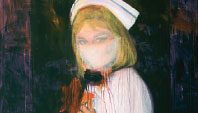
Richard Prince
King of appropriation. Didn’t stop after inventing or uncovering unknown pictorial conventions deeply embedded in visual culture. Adopting various personae, he’s a fountainhead for many artists.
David Hammons
Work involving sticks and stones, hair, found objects, and snow that grabs you by the lapels. Hammons’s sculpture has underground cred and a complex beauty. Once said, “I can’t stand art, actually. I’ve never ever liked art … it was never that important to me.”

Vito Acconci
The original man in black followed people on city streets, masturbated for a week under a gallery floor, and made some of the more outlandish sculpture of the past fifteen years. Proves that an artist can behave in public exactly as in the studio. For that alone, deserves a MacArthur.
Maurizio Cattelan
More philosopher and metaphysician than mere jester (though he does make you laugh). Turns sculpture into Plato’s cave, where reality and illusion merge and change places. Probably best known for The Ninth Hour, a Mme. Tussaud’s–realistic figure of Pope John Paul II struck down by a meteorite.
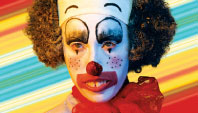
Cindy Sherman
Launched a thousand theories, with a persona so simple that no one has ever come out and said exactly what it is: a woman who likes to shop, bring home clothes, try them on, and take her own picture. This formula, repeated thousands of times over three decades, has shed exactly no light on the real Sherman—and, through some alchemic miracle, tells us just who we think we are.
John Currin
So conservative he’s radical, so radical he’s conservative. His quietly satirical paintings of contemporary figures, rendered with Old Master strokes, have an initial wallop and are embedded with thoughtful, dark intelligence, sincerity, and skepticism. Our H.L. Mencken.
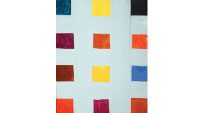
Mary Heilmann
Painter, ceramist, trouper. Makes easy-does-it, smart geometric process paintings, rendered in bright jewel-like colors, their surfaces inflected with touch and nuance. Heilmann’s work has a certain longing and joy, so pure that it’s just outside the reach of language.
Cady Noland
The most radical artist of the eighties. Made sculptures of beer cans, silk-screened images of Lee Harvey Oswald being shot, little American flags hanging from metal fence poles. Exploded logical linearity, created a new narrative format, predicted a hundred other artists, and then all but disappeared.

Kara Walker
Our own Queen of the Night, a disturber of the peace and all that rests just beneath the surface of American history. Walker is an American Goya, seeing the sleep of reason in our tortured history of race.
Nan Goldin
No one gets better what life looks like the moment before it turns to ash. The keeper of the Book of the Dead of a generation that broke free but was stalked by aids and death. Lately, made her work a diary of her own wrecked cabinet of demons. May she survive her season in hell.

Marina Abramovic
Has stood still for hours, rubbed her skin raw with bones, and reenacted that Vito Acconci marathon wank under the floor of the Guggenheim. Deals in taboo, transgression, laughter, forgetting, and the Slavic mind. A crosser of bodily frontiers, a mortifier of her own flesh, a martyr, a devil, and a saint of pain and love.
Christopher Wool
Began with word paintings (of the Apocalypse Now line “Sell the house, sell the car, sell the kids”). Forays into screened and reproductive formats paved the way for a generation interested in both making it new and making it again.
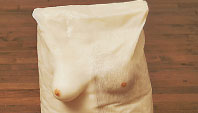
Robert Gober
Gober’s language of fragmented body parts and everyday objects is sculpture as sexual stand-in, broadside, poetry. His earliest work is proof that an artist can be making mature work years before he even knows it—everything is part of the overall journey.
Rirkrit Tiravanija
The pioneer of so-called relational aesthetics. Unlike almost all artists, found a way to give his art away: He cooks for people, and they eat, in a gesture that lowers boundaries around art and in galleries.
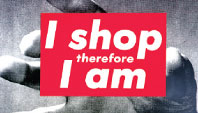
Barbara Kruger
Her posterlike graphics displaying basic mottoes are a potent, recognizable, and singular invention, one that creates an elaborate network of inside-and-outside, deep-and-deeper addresses to the nation. One of the sharpest minds and wits around, and perhaps the best artist-writer of her generation.
Janine Antoni
Makes sculptures boiling down desire and memory into dense objects. Has used dreams, tightrope walking, chocolate, soap, and hair to re-create primal mythic dramas, forgotten lore, and old magic. Her work with her parents is among the best of this kind ever made.
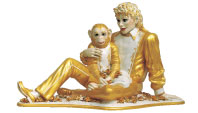
Jeff Koons
If Warhol was surface all the way to the core, Koons is empty all the way in—empty like a fox. An impish, non-knowing Everyman, the Ronald Reagan of sculpture. So perfectionist that he once went nearly ten years without a gallery show in New York.
Vanessa Beecroft
Her basic idea—women stand naked in rows in front of gallery audiences for hours, like classical sculptures—crawls into a mental crevice and roots there. If a man made this work, he’d be instantly thrown out of the art world. That it’s Beecroft’s doesn’t make it any easier to take.
Barry Le Va
The Colonel Kurtz of sculpture. Le Va made his bones running into walls in the mid-sixties and, later, shattering huge sheets of glass. Since then, has made difficult-to-process but beautiful installations.

Karen Kilimnik
A dark force of chaos, the girl who never cleaned her room, a mistress of disordered longing, Russian novels, grand ballets, and pop culture. Gave herself permission to leave her awkward strokes as is, in the process offering the same release to hundreds of other artists. A door-opener of the first order.